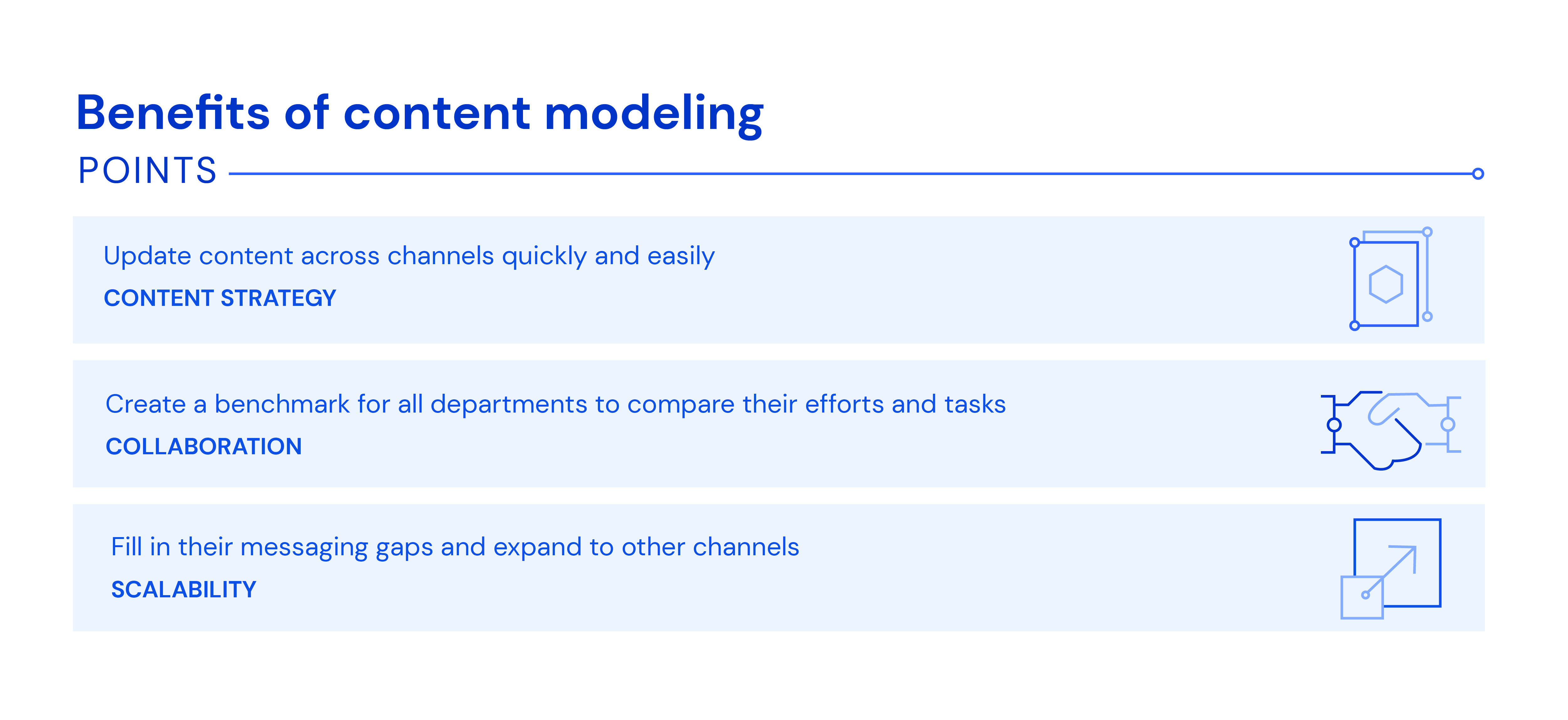Content modeling is the process of cataloging, describing, and disassembling your organization’s content, such as that on your website, mobile app, explainer videos, blogs, and FAQs. All visible content must be part of your content model and, through proper modeling, content becomes easy to manage, implement, and scale.
Before defining content modeling, let’s first specify what content modeling isn’t. Though similar to database schemas, content models require that you consider how people will be creating and interacting with that content. Therefore, content modeling is the foundation for building, governing, and growing your company’s digital experience. Cross-functional teams who model content should focus on aligning user needs with the organization’s offers.
When designing modern websites, front-end and back-end developers must produce omnichannel content across platforms. Your content model is the key to integrating all those channels and components into a compelling user experience—one that not only caters to users but also delivers consistent branding and messaging throughout.
Effective content modeling organizes your content into components that can be reused and that, being relatable to other components, can be easily updated across multiple sources.
Since global market pressures and competition often leave you feeling that you must constantly rush to take content live, why spend precious time developing a content model? The core benefits explained below answer that question, convincing you that you would be wise to leave the haphazard approach behind in favor of the steady and methodical method of building and implementing a content model.
Content strategy
In addition to shortening the production timeline, content modeling also boosts
content strategy because, first of all, with a unifying plan for your entire content scope, your teams can update content across channels quickly and easily. Second, SEO keywords remain current; old content receive a “refresh;” and designers can beef up the UX—all keeping up with and might even surpassing the competition.
Hashing out and adopting a clear, concise content model enhances each and every stage of the process. Above all, specifying your organization's
single system of truth (SSoT) to your team raises the accuracy and speed of the content-production process.
Collaboration
Building and using a content model within your organization does magic for your team in the form of a source of truth—a benchmark for all departments to compare their efforts and tasks. With your content model as the guiding light for what’s currently live, what will be going live, and how everything works together, people can easily collaborate—sans team-by-team silos.
In addition, teams can comment on or update content directly in-doc, and project stakeholders can tag the appropriate team members regardless of which department or team they belong to. Intraoffice lines of communication then become veritable “superhighways,” significantly reducing the production timeline.
Scalability
Scalability refers to—
- The ability to deploy content in more channels.
- Reduction of the amount of re-created content through standardization and findability.
Ensuring that your content model is always a consistent source of truth and constantly updating the content itself embodies
scalability. In being able to readily consult your model, see what content pieces are live, where they are, and what they consist of, businesses can fill in their messaging gaps and expand to other channels.
Be sure to analyze your current marketing inventory so as to adapt media like videos, images, and links to various advertising channels. For example, if you’re running an explainer video on your website and would like to run optimally on another platform, you might need to change the video’s components or dimensions.
As important as it is to scale your content efforts, do so properly. Content modeling is instrumental in supporting your scaling efforts while maintaining the effectiveness and integrity of your content pieces.
What should your content model entail? The related process consists of two key components: content types and content attributes.
Content types
As a framework for your content, content types, e.g., digital courses, blog posts, biographies, and product pages, lay the foundation for the modeling process. Think of them as a template for the content you’re creating.
Content attributes
Content attributes are the elements of the components that make up each content piece. Together, those attributes comprise the content types in your model.
Say, for example, product pages are one of your content types, containing components like product name, product description, pricing, subscription packages, etc. Each of those components on your larger product page is a content attribute.
Content relationships
No content in your digital experience exists on its own, each piece relating to another in some way, shape, or form. In fact, a content model is simply a more formal representation of those relationships.
Within your content model, content relationships are just as important as the content types. Altogether, you must consider
three types of relationships:
- A whole or partial relationship: A larger content whole owns smaller content parts. Examples are an online course and its modules and an ebook along with its chapters. Here, the smaller components last only as long as the larger whole does. Once the whole is gone, all the parts vanish.
- An aggregation relationship: Content wholes and parts are still connected, but more loosely. Here, an ebook wouldn’t overtly own all its chapters, or an online course its modules. The primary benefit of this relationship model is that the parts, i.e., chapters or modules, still exist after the whole is deleted.
- A dependency relationship: This relationship is useful in the early stages of content creation when you’re unsure how exactly two content pieces relate to each other.
- Collaborate with stakeholders.
- Choose a strategy.
- Create a content map.
- Implement the model.
1. Collaborate with stakeholders
To start with, all stakeholders must brainstorm the path for each content piece. Think and talk through things together, e.g., how you’ll present content, how users will ideally interact with it once it’s live, and what the ultimate outcome of those interactions should be.
Be sure to involve stakeholders from all departments, not just back-end and front-end developers, in the early stages of the process. Writers, those in charge of visual components, and project managers must also have an equal say.
2. Choose a strategy
You have two primary frameworks to choose from for a content-modeling strategy: top-down and bottom-up.
Top-down content modeling puts the ultimate outcome of your content at the forefront. By considering the outcome first, teams can focus on what their content should look like and do (if it’s interactive) and then reverse-engineer the related components from there. This “macro-to-micro” approach guides content in a more modular, plug-and-play direction, streamlining the production process for future content.
Bottom-up modeling method works oppositely. Teams focus on the details first and decide which content components to recycle across other pieces. Afterwards, project stakeholders link those smaller content attributes together through relations, creating small content “blocks” that can be slid into the appropriate places to ensure the best communication and information structure overall.
3. Create a content map
Don’t worry about interpreting content objects into a webpage, mobile app, and in-venue digital signage just yet. Rather, focus on building a solid foundation of content types and attributes to smooth out the process of scaling to other marketing channels at the opportune time.
With a content map, teams can see how the whole process plays out. Start by listing the content types and their attributes, and then draw lines to connect those attributes that work together through relations.
By visually laying out all content types that way, you can see at a glance all the content attributes in play. Additionally, specifying the relationships among those attributes in visual form highlights the opportunities for repurposing content across various types, ultimately streamlining your strategy across channels and
content pillars.
4. Implement your content model
Your content model is now complete, awaiting implementation. Ensure that all stakeholders (and all departments in general) know where the model lives: Is it live on your company’s content management system (CMS), or is a spreadsheet available on a cloud drive for access and reference?
Communicating within the company network the content model’s location and the related directives ascertains that all stakeholders are on the same page and can leverage their full power and intent.
Synthesizing core content into a digital experience isn’t always straightforward. For one thing, teams often want to pull content from different sources and blend it with channel-specific content or presentation guidance.
Through the benefits of Uniform, instead of having to—
- Take a piece of core content from your CMS.
- Pair the content with a stock photo from your digital asset management (DAM) system.
- Add a header on a landing page for context.
—you can:
- Add a side-by-side component and specify the widths.
- Select the core content from the CMS with a focus on the core, cross-channel content.
- Select an image from a DAM system to comply with digital-asset governance.
- Add a heading, which is relevant on this landing page only, directly in Uniform.
The above example shows how, by content modeling ahead of time, you can ensure that each system in the stack serves its intended purpose: CMS for core content, DAM for digital-asset governance and delivery, and Uniform for collection of channel-specific experiences.










.jpg&w=1024&q=90)
.jpg&w=1024&q=90)